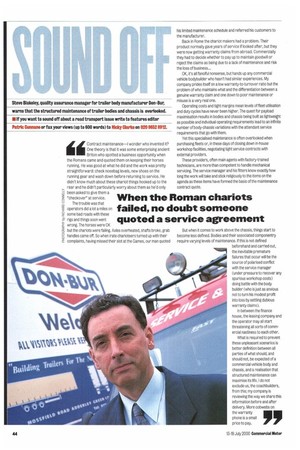dd Contract maintenance—I wonder who invented it? One theory is that
Page 46

If you've noticed an error in this article please click here to report it so we can fix it.
it was some enterprising ancient Briton who spotted a business opportunity when the Romans came and quoted them on keeping their horses running. He was good at what he did and the work was pretty straightforward: check nosebag levels, new shoes on the running gear and wash down before returning to service. He didn't know much about these chariot things hooked up to the rear and he didn't particularly worry about them as he'd only
El, been asked to give them a "checkover at service. 0
The trouble was that -T. operators did a lot a miles on some bad roads with these figs and things soon went
• wrong. The horses were OK • but the chariots were failing. Axles overheated, shafts broke, grab 6 ▪ handles came off So when irate charioteers turned up with their 0 E complaints, having missed their slot at the Games, our man quoted his limited maintenance schedule and referred his customers to the manufacturer.
Back in Rome the chariot makers had a problem. Their product normally gave years of service if looked after, but they were now getting warranty claims from abroad. Commercially they had to decide whether to pay up to maintain goodwill or reject the claims as being due to a lack of maintenance and risk the loss of business...
OK, it's all fanciful nonsense, but hands up any commercial vehicle bodybuilder who hasn't had similar experiences. My company prides itself on a low warranty-to-turnover ratio but the problem of who maintains what and the differentiation between a genuine warranty claim and one down to poor maintenance or misuse is a very real one.
Operating costs and tight margins mean levels of fleet utilisation and duty cycles have never been higher. The quest for payload maximisation results in bodies and chassis being built as lightweiet as possible and individual operating requirements lead to an infinite number of body-chassis variations with the attendant service requirements that go with them.
Yet this specialised maintenance is often overlooked when purchasing fleets or, in these days of closing dawn in-house workshop facades, negotiating tight service contracts with external providers.
These providers, often main agents with factory-trained technicians, are more than competent to handle mechanical servicing. The service manager and his fitters know exactly how long the work will take and stick religiously to the items on the agenda as these items have formed the basis of the maintenance contract quote.
But when it comes to work above the chassis, things start to become less defined. Bodies and their associated componentry require varying levels of maintenance. If this is not defined beforehand and carried out, the inevitable premature failures that occur will be the source of polarised conflict with the service manager (under pressure to recover any spurious workshop costs) doing battle with the body builder (who is just as anxious not to turn his modest profit into loss by settling dubious warranty claims).
In between the finance house, the leasing company and the operator may all start threatening all sorts of commercial nastiness to each other.
What is required to prevent these unpleasant scenarios is better definition between all parties of what should, and should not, be expected of a commercial vehicle body and chassis, and a realisation that structured maintenance can maximise its life. i do not exclude us, the coachbuilders, from this; my company is reviewing the way we share this information before and after delivery. More cobwebs on the warranty phone is a small price to pay.




































































































